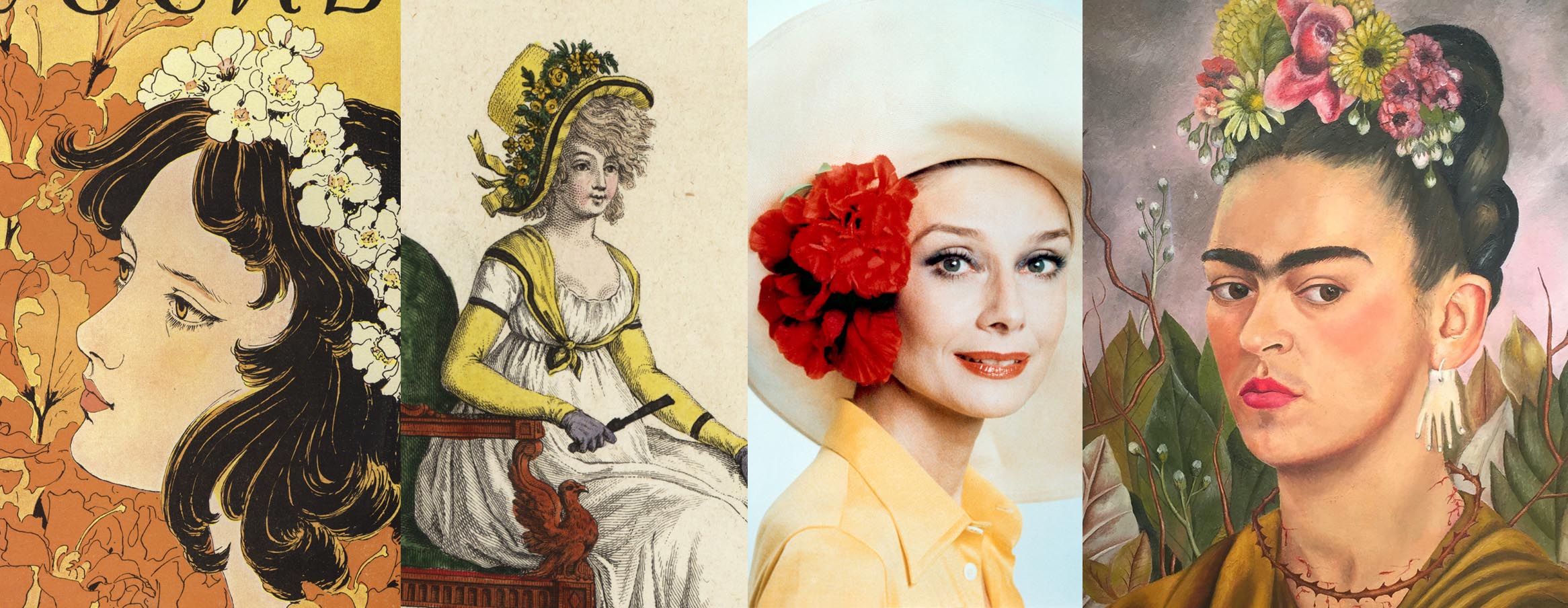
Flowers as fashion through history
Flowers have been worn as decoration in the hair for centuries. They symbolise love, peace and beauty, and on a less conceptual level offer a delicate floral touch to a summer outfit. These images are feminine in style and display a wide range of flower species, all of which are beautiful in their colours, patterns and petal configurations. The way the flowers are worn on an outfit also has additional implications.
In this 1897 illustration set in a park, a gentleman is shown placing a blossom into a woman's hair. Blossom is loved for its pretty shades of pink, but is notoriously short lived, dropping from trees not long after fully blooming. The style is illustrative, but with painterly and delicate usage of colour on the surrounding illustration.
The fauvist style favoured by artists such as Henri Matisse and André Derain was extremely controversial at the time, but there is no denying it is well suited to vibrant floral themed portraits! The modest scale of this piece by John Duncan Fergusson indicates that it may have been a study, with intense shades of rose and pink utilised to highlight skin tones and a bright flower garland commanding the most attention.
Gaston Bussière was a French nineteenth century symbolist artist. he created major works for authors of the time including Theophile Gautier, French writer and poet. French Symbolist painter and illustrator Gaston Bussière has a remarkable body of work including his painting Bathing Nymphs 1897, which includes the most beautiful bright purple flowers both in the background but also worn as a flower garland.
Irene Bennett wears flowers in her hair in this 1936 publicity photograph. An actress known for comedy and romance features such as ‘Lady Be Careful’ (1936), the film has a narrative of American sailors in the pre WW2 world chasing high society ladies. Coupled with the long pearl necklace and velvet gown, her costume here is almost evocative of ancient greek or renaissance styles.
This cover illustration from an 1896 issue of Jugend ('youth') depicts a dark haired girl with flowers in her hair. Jugend was a Munich based illustrated weekly magazine covering themes surrounding art, culture and life. In spite of its age this illustration looks remarkably contemporary and is extremely evocative of the style of Alphonse Mucha, whose Art Noveau pieces typified the whole aesthetic of 'New Art'. Her flower garland is picked out in a delicate yellow and creamy white which contrasts with the bright, vibrant orange.
Frida Kahlo, the prominent feminist Mexican painter inspired by the natural world and her struggles as an artist painted this self portrait to her Doctor, ‘Dr Eloesser’, who had treated pain that she had suffered from in her right foot during a visit in San Francisco. The colours, which are predominantly rather earthy in much of Kahlo's work are said to replicate natural colours of Mexico. The flowers are pink, purple, yellow and green in colour, and are deliberately exotic and unfamiliar, with dried out twigs and what appear to be cactus flowers adorning her garland. Kahlo's typical imagery of spider esque branches, a necklace of thorns and texts/fabrics are all present.
In August 1901, Paul Gaugin arrived in the remote village of Atuona, Hiva Oa in the Marquesas Islands. He built his 'house of pleasure' decorated with his paintings and wood carvings, but his ill health and lack of money gradually worsened his already straining health issues. He painted his last masterpieces while living there. Gauguin perceived that which would otherwise be known as "barbarian" and "savage" as morally wholesome and indicative of a primordial purity, a healthier and more normal state of human condition than our western culture would have one believe. Before Pablo Picasso and André Derain discovered African art, Gauguin found his inspiration in primitive arts. Gauguin seems to have attempted a reconciliation between his Western past, and the more "savage" Polynesia. The West is represented here by the figure of the painter Meyer de Haan (1852-1895), a friend of Gauguin. Careful observation reveals the suggestion of a demonic aspect to Meyer de Haan's character, which may imply a West that is secretly corrupt. On the other hand, the native culture is represented by two stoical Polynesian figures. The dark haired woman sits in a buddhist pose.
This portrait lovingly depicts Sidonie-Gabrielle Colette (28 January 1873 – 3 August 1954), known mononymously as Colette, a French author and woman of letters. She was also known as a mime, actress, and journalist. Jacques-Ferdinand Humbert was a French painter who specialised in portraits and historical scenes, and here he places emphasis on the flower worn in Colette's hair with a vibrant but restrained red colouration. It stands out against the muted browns and greys of the rest of the painting.








